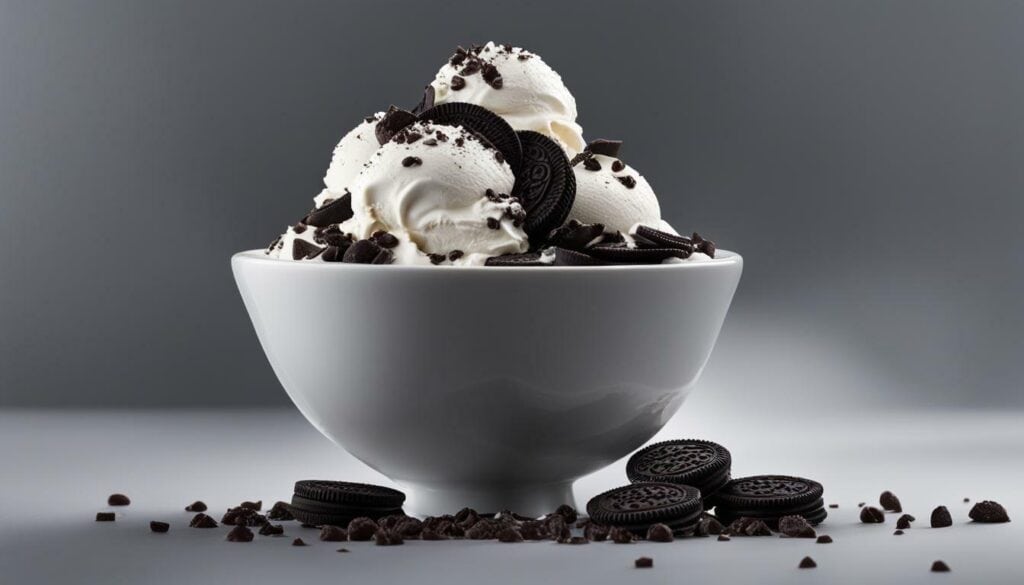Are you curious about the calorie content of your favorite Oreo ice cream? When it comes to indulging in this beloved frozen treat, it’s important to be aware of the nutritional information and make informed choices. In this article, we will uncover the surprising truth about the calories in Oreo ice cream, explore low-calorie and healthier alternatives, compare it to fast food favorites, and discuss the impact of dairy vs. dairy-free options. Let’s dive in and discover the facts behind this delicious dessert!
Key Takeaways:
- Oreo ice cream can vary in calorie content, so it’s important to check the nutritional information.
- There are low-calorie options available for Oreo ice cream lovers who want to watch their calorie intake.
- Choosing a healthier Oreo ice cream alternative can be an option for those looking for a more nutritious treat.
- Comparing the calorie content of Oreo ice cream to fast food items highlights the need for moderation and awareness.
- Dairy-free options can be lower in calories and fat, but not all dairy-free ice creams are created equal.
Now that we’ve laid out the key takeaways, let’s delve into the specifics of the calorie content in Oreo ice cream and explore the options available for those seeking a healthier treat.
The Surprising Truth: Calories in Oreo Ice Cream
Let’s dive into the nutritional facts of Oreo ice cream to uncover the surprising truth about its calorie content. When it comes to indulging in this popular treat, it’s essential to be aware of the calories and nutritional information to make informed choices.
One serving of Oreo ice cream typically contains around 300 calories, making it a high-calorie dessert option. The combination of creamy vanilla ice cream and crushed Oreo cookies creates a deliciously satisfying treat that can quickly add up in terms of calorie intake.
Additionally, Oreo ice cream is not low in fat, with each serving containing approximately 17 grams. It’s important to keep in mind that consuming excessive amounts of saturated fat can negatively impact heart health. Therefore, moderation is key when enjoying this tasty dessert.
| Nutritional Information per Serving of Oreo Ice Cream: | |
|---|---|
| Calories | 280 |
| Total Fat | 17g |
| Saturated Fat | 9g |
| Carbohydrates | 34g |
| Sugar | 24g |
| Protein | 4g |

While Oreo ice cream can be a delightful indulgence, it’s crucial to be mindful of portion sizes and enjoy it in moderation. Pairing it with a balanced diet and an active lifestyle can help maintain a healthy lifestyle while still satisfying the craving for this creamy dessert.
Low-Calorie Options for Oreo Ice Cream Lovers
For those looking to enjoy Oreo ice cream without the guilt, there are some fantastic low-calorie alternatives available. These options offer all the deliciousness of Oreo ice cream with fewer calories, making them a great choice for anyone watching their waistline. Whether you’re counting calories or simply looking for a healthier option, these low-calorie alternatives won’t disappoint.
One popular choice is Halo Top’s Oreo Cookie frozen dessert. With only 70 calories per serving, this guilt-free treat is packed with Oreo cookie pieces and a creamy texture that will satisfy your cravings. It’s also low in sugar, making it a suitable option for those watching their sugar intake.
Another great alternative is Arctic Zero’s Fit Frozen Dessert in Oreo flavor. This low-calorie option contains just 75 calories per serving and is made with natural ingredients such as whey protein and monk fruit. It’s also gluten-free and contains no artificial sweeteners, perfect for those with dietary restrictions or looking for a clean label option.
| Low-Calorie Oreo Ice Cream Options | Calories per Serving |
|---|---|
| Halo Top’s Oreo Cookie Frozen Dessert | 70 |
| Arctic Zero’s Fit Frozen Dessert – Oreo Flavor | 75 |
These low-calorie alternatives prove that you don’t have to sacrifice taste to enjoy a healthier ice cream option. By choosing these low-calorie Oreo ice cream alternatives, you can indulge in your favorite treat without the guilt. So go ahead, grab a spoon, and savor the creamy goodness of Oreo ice cream, all while staying on track with your health and wellness goals.

If you’re aiming for a healthier treat, don’t worry – there are plenty of options out there to satisfy your Oreo ice cream cravings. When it comes to indulging in this delicious frozen dessert, making smarter choices can help you enjoy the flavors you love while keeping your health goals in mind.
One alternative to consider is opting for low-calorie Oreo ice cream. Many brands now offer light or reduced-calorie versions of their products, which can help you save on calories without compromising on taste. These options often use alternative sweeteners or lower-fat ingredients, making them a great choice for those watching their calorie intake.
If you’re looking for a healthier ice cream option, consider trying dairy-free versions. These options are often made with plant-based ingredients such as almond milk or cashew milk, which can provide a lighter and lower-calorie alternative to traditional dairy ice cream. Just make sure to check the label for any additional added sugars or unhealthy additives.
| Calorie Comparison | Oreo Ice Cream | Low-Calorie Option | Dairy-Free Option |
|---|---|---|---|
| Calories per serving | 280 | 120 | 160 |
| Saturated fat | 10g | 2g | 4g |
| Protein | 4g | 2g | 1g |
When choosing a healthier Oreo ice cream option, be sure to read the labels and compare the nutritional information. Look for products that are lower in calories, saturated fat, and added sugars. Additionally, consider portion control – enjoying a smaller serving size can help you satisfy your sweet tooth while keeping your calorie intake in check. Remember, moderation is key!

“Choosing a healthier Oreo ice cream doesn’t mean sacrificing flavor. With so many options available, you can enjoy a guilt-free indulgence that satisfies your cravings and keeps you on track with your health goals.”
Comparing Oreo Ice Cream to Fast Food Favorites
You might be surprised to learn how the calorie and salt content of Oreo ice cream stacks up against fast food favorites like KFC chicken and McDonald’s fries. When it comes to indulgent treats, it’s important to consider the nutritional content and make informed choices.
To give you a better understanding, I’ve compiled a comparison table of the calorie and salt content in Oreo ice cream and popular fast food items:
| Ice Cream/Fast Food Item | Calories per Serving | Salt (mg) per Serving |
|---|---|---|
| Oreo Ice Cream | 280 | 160 |
| KFC Chicken (1 piece) | 320 | 1,120 |
| McDonald’s Fries (Medium) | 340 | 270 |
As you can see, Oreo ice cream is a relatively lower calorie option compared to fast food favorites like KFC chicken and McDonald’s fries. However, it’s important to note that the salt content in Oreo ice cream is still significant. While it may be a delicious treat, moderation is key to maintaining a balanced diet.
Remember, it’s always a good idea to read the nutrition labels and be mindful of portion sizes when enjoying indulgent treats like Oreo ice cream. By making informed choices and finding a balance, you can still savor your favorite desserts without compromising your health goals.

The Impact of Dairy vs. Dairy-Free Oreo Ice Cream
Understanding the impact of dairy versus dairy-free options can help you make more informed choices when it comes to Oreo ice cream. When it comes to ice cream, there is a lot to consider in terms of calories and nutritional content. Some dairy-free ice creams can be relatively low in fat and calories, making them a reasonable indulgence for those watching their weight or heart health.
However, not all dairy-free ice creams are created equal, and some can be higher in calories and saturated fat. Ice creams made with coconut milk tend to be higher in saturated fat, while those made with dairy have higher calcium and protein content. It’s important to read the labels and understand the nutritional profile of the ice cream you choose.
To give you a better idea of the nutritional content, let’s take a look at a comparison between dairy Oreo ice cream and a popular dairy-free option:
As you can see, the dairy-free option has fewer calories, lower saturated fat content, and a slightly lower sugar content compared to the traditional Oreo ice cream. However, it’s important to note that individual serving sizes may vary, so be sure to check the packaging for accurate information.
Whether you opt for dairy or dairy-free Oreo ice cream, remember to enjoy these treats in moderation as part of a balanced diet. Making informed choices and being mindful of the nutritional content can help you satisfy your sweet tooth while still maintaining a healthy lifestyle.

Saturated fat is a key consideration when it comes to Oreo ice cream, especially for those watching their heart health. While indulging in this creamy treat can be satisfying, it’s important to be aware of the impact that saturated fat can have on our bodies.
When we consume foods high in saturated fat, such as Oreo ice cream, it can raise our cholesterol levels. High cholesterol is a risk factor for heart disease, which is why it’s important to limit our intake of saturated fat. According to the American Heart Association, saturated fat should make up no more than 5-6% of our daily caloric intake.
So, how does Oreo ice cream stack up in terms of saturated fat content? One serving of Oreo ice cream can contain around 6 grams of saturated fat, which is approximately 30% of the recommended daily limit for an average adult. This means that enjoying Oreo ice cream should be done in moderation, as part of a balanced diet.
Choosing lower-saturated fat alternatives can be a wise decision for those looking to indulge in Oreo ice cream without compromising their heart health. There are several dairy-free options available that use plant-based fats, such as almond or soy milk, which can provide a creamy texture without the same level of saturated fat. Additionally, opting for smaller portion sizes or enjoying Oreo ice cream as an occasional treat can also help to manage saturated fat intake.

When it comes to the impact on calories, fat, and nutritional content, the choice between dairy and dairy-free Oreo ice cream can make a significant difference. Dairy-based Oreo ice cream tends to have higher calcium and protein content due to the milk used in its production. However, it can also be higher in saturated fat.
Dairy-free Oreo ice cream, on the other hand, often utilizes coconut milk or other plant-based substitutes. While these alternatives may be lower in saturated fat, they can still be relatively high in calories. It’s important to read the nutrition labels and compare options to ensure you are making the best choice for your dietary needs.
Ultimately, whether you choose dairy or dairy-free Oreo ice cream, being mindful of portion sizes and incorporating it into a balanced diet is key. By understanding the role of saturated fat and considering other nutritional factors, you can make informed choices that align with your health goals while still enjoying the occasional Oreo ice cream treat.
Making Informed Choices for Oreo Ice Cream Treats
With so many options available, it’s important to know how to make the best choices for your Oreo ice cream treats. When it comes to indulging in this delicious dessert, being mindful of the nutritional content can help you make healthier decisions without sacrificing flavor.
One way to make a more informed choice is by opting for low-calorie options. Many brands now offer lighter versions of Oreo ice cream, which can be a great way to satisfy your cravings while keeping your calorie intake in check. These low-calorie options typically have fewer calories per serving and can be a healthier alternative for those watching their weight.
Another aspect to consider is the type of ice cream base. Dairy-based Oreo ice cream tends to be higher in calcium and protein, making it a good choice for those looking to increase their intake of these nutrients. However, if you’re lactose intolerant or prefer a plant-based diet, there are also dairy-free alternatives available. Just keep in mind that some dairy-free ice creams, especially those made with coconut milk, can be higher in saturated fat. Read the nutritional labels carefully to make sure you’re choosing a healthier option.
| Product | Calories per Serving | Sodium (mg) per Serving |
|---|---|---|
| Lotus Biscoff Ice Cream | 220 | 80 |
| Oreo Ice Cream | 250 | 160 |
| KFC Chicken (1 piece) | 290 | 1200 |
| McDonald’s Fries (Medium) | 340 | 160 |
Lastly, keep in mind that moderation is key. While it’s okay to indulge in Oreo ice cream occasionally, it’s important not to overdo it. Try to savor the flavor and enjoy it mindfully rather than mindlessly consuming it. Remember, making informed choices about your Oreo ice cream treats allows you to fully enjoy them while also taking care of your health.
Additional Resources:
- Healthline: Low-Calorie Ice Cream Brands
- British Nutrition Foundation: Dairy-Free Diets
- American Heart Association: Saturated Fats

In conclusion, being aware of the calories and nutritional content in Oreo ice cream can help you satisfy your sweet tooth while still maintaining a healthy lifestyle. When it comes to indulging in ice cream, it’s important to make informed choices.
Some dairy-free ice creams can be a good option for those watching their weight or heart health, as they tend to be lower in fat and calories. However, not all dairy-free options are created equal. Ice creams made with coconut milk, for example, can be higher in saturated fat.
On the other hand, ice creams made with dairy have higher calcium and protein content. So, if you’re looking for added nutritional benefits, opting for a dairy-based Oreo ice cream might be a better choice.
It’s worth noting that certain Oreo ice cream products, like Lotus Biscoff and some Oreo flavors, have been found to have high calorie and salt content. In fact, they can be comparable to popular fast food items like KFC chicken and McDonald’s fries. Therefore, it’s essential to be mindful of the nutritional content and enjoy these treats in moderation.
FAQ
Q: Are all dairy-free ice creams low in calories?
A: No, not all dairy-free ice creams are low in calories. Some can be relatively high in calories and saturated fat. It’s important to read the nutritional information and choose wisely.
Q: Are Oreo ice cream products high in calories and salt?
A: Yes, Oreo ice cream products have been found to have high calorie and salt content, similar to fast food items like KFC chicken and McDonald’s fries.
Q: Are there low-calorie options for Oreo ice cream lovers?
A: Yes, there are low-calorie alternatives available for Oreo ice cream lovers. Look for healthier options that have reduced calorie content.
Q: Are there healthier choices for Oreo ice cream?
A: Yes, there are healthier choices for Oreo ice cream available. These options often have lower calorie and fat content. Look for options made with healthier ingredients.
Q: How does dairy vs. dairy-free Oreo ice cream differ nutritionally?
A: Dairy-free Oreo ice cream tends to have lower calcium and protein content compared to Oreo ice cream made with dairy. Dairy-free options also vary in terms of calorie and fat content.
Q: What is the role of saturated fat in Oreo ice cream?
A: Oreo ice cream, especially those made with dairy, can be higher in saturated fat. It’s important to be mindful of this as excessive saturated fat intake can impact heart health.
Q: How can I make informed choices for Oreo ice cream treats?
A: To make informed choices for Oreo ice cream treats, read the nutritional information, choose lower calorie and lower fat options, and consider portion sizes. Balance indulgence with overall dietary goals.
How Many Calories are in a Cup of Vanilla Ice Cream Compared to Oreo Ice Cream?
When comparing the calories in vanilla ice cream to Oreo ice cream, it is important to note that vanilla ice cream typically contains fewer calories. A cup of vanilla ice cream generally has around 250 calories, whereas a cup of Oreo ice cream can have around 300 calories due to the addition of cookies. So, if you’re looking for a lower-calorie option, vanilla ice cream may be the way to go.
What Are the Caloric Content in Strawberry Cheesecake Compared to Oreo Ice Cream?
The calories in strawberry cheesecake vary depending on ingredients and portion size. Typically, a slice of strawberry cheesecake contains around 300-400 calories. In comparison, a serving of Oreo ice cream averages 150-200 calories. It’s essential to consider the serving size and your dietary goals when choosing between these two delicious desserts.





Leave a Reply